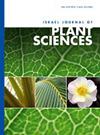利用物化特性分析毛里亚紫枣(Ziziphus mauritiana L.)品种遗传多样性
IF 0.9
4区 生物学
Q4 PLANT SCIENCES
引用次数: 0
摘要
本试验对12个印度大枣品种的理化多样性进行了评价。对总共15个数量性状进行了探索,并进行了多变量分析。在所研究的ber品种中观察到显著的变异性。Pearson的相关分析确定了第一次开花的天数、每个簇的花数和每个簇的保留果实数,这可以作为鉴定高产ber品种的选择基础。主成分分析(PCA)估计,PC1和PC2对ber品种总变异性的贡献率为60.2%。前两个组成部分的散点图突出了每簇保留果实的数量、每棵树的产量、果肉重量、果实宽度、核重和每簇花的数量,它们是对总变异性起重要作用的主要特征。此外,主成分分析也有助于确定Mehrun、Manuki和Chhuhara是相对于PC1和PC2表现良好的优良ber品种。Mahalanobis D2统计数据将所有12个ber品种分为5个聚类,表明这些品种之间存在充足的遗传多样性。考虑到簇间距离和簇平均值,可以得出结论,簇II和簇III的品种可以用来估计有效利用杂种优势的配合力或分离出理想的海侵分体。本文章由计算机程序翻译,如有差异,请以英文原文为准。
Genetic diversity of ber (Ziziphus mauritiana L.) cultivars using physico-chemical characteristics
The present experiment was conducted to estimate the physico-chemical diversity of twelve Indian jujube cultivars. A sum of fifteen quantitative characters were explored and subjected to multivariate analyses. Significant variability was observed across the ber cultivars under study. Pearson’s correlation analysis identified days to first flower initiation, a higher number of flowers per cluster and a higher number of retained fruits per cluster which could be used as the basis of selection for identification of high yielding ber cultivars. The principal component analysis (PCA) estimates 60.2% of the total variability in ber cultivars is contributed by PC1 and PC2. The scatter plot of the first two components highlights the number of retained fruits per cluster, yield per tree, pulp weight, fruit width, stone weight and number of flowers per cluster as principal characters that played a significant role in the total variability. Further, PCA also helped to identify Mehrun, Manuki and Chhuhara as superior ber cultivars which performed well with respect to the PC1 and PC2. The Mahalanobis D2 statistics grouped all the twelve ber cultivars into five clusters indicating the existence of ample genetic diversity among the cultivars. Considering the inter-cluster distance along with cluster mean it could be concluded that the cultivars of cluster II and Cluster III may be utilized to estimate the combining ability for effective exploitation of heterosis or to isolate desirable transgressive segregants.
求助全文
通过发布文献求助,成功后即可免费获取论文全文。
去求助
来源期刊

Israel Journal of Plant Sciences
生物-植物科学
CiteScore
1.90
自引率
0.00%
发文量
17
审稿时长
>12 weeks
期刊介绍:
The Israel Journal of Plant Sciences is an international journal of extensive scope that publishes special issues dealing with all aspects of plant sciences, including but not limited to: physiology, cell biology, development, botany, genetic
 求助内容:
求助内容: 应助结果提醒方式:
应助结果提醒方式:


